小学英语课上“休息”方式种种
中小学生中午如何休息英语作文
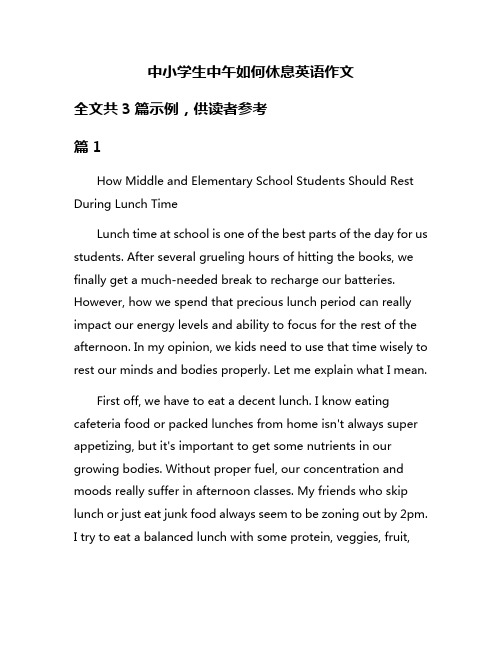
中小学生中午如何休息英语作文全文共3篇示例,供读者参考篇1How Middle and Elementary School Students Should Rest During Lunch TimeLunch time at school is one of the best parts of the day for us students. After several grueling hours of hitting the books, we finally get a much-needed break to recharge our batteries. However, how we spend that precious lunch period can really impact our energy levels and ability to focus for the rest of the afternoon. In my opinion, we kids need to use that time wisely to rest our minds and bodies properly. Let me explain what I mean.First off, we have to eat a decent lunch. I know eating cafeteria food or packed lunches from home isn't always super appetizing, but it's important to get some nutrients in our growing bodies. Without proper fuel, our concentration and moods really suffer in afternoon classes. My friends who skip lunch or just eat junk food always seem to be zoning out by 2pm.I try to eat a balanced lunch with some protein, veggies, fruit,and carbs to give me an energy boost without making me feel sluggish.Secondly, and just as crucially, we need to let our minds take a break from schoolwork during lunch. I see so many of my classmates using the entire lunch period to cram for a test, finish homework, or study. While I admire their work ethic, I think this is a terrible idea that leads to burnout. Our brains are like muscles that need rest periods between exercises. If we keep them in mental workout mode all day, we'll just hit a wall eventually. The lunch break is our chance to shut off the academic part of our brains for a little while before we have to ramp it back up again.So if we shouldn't be studying during lunch, what should we do instead? In my view, the ideal lunch period involves a blend of physical activity, socialization, and just zoning out for a bit. Getting some exercise is key, whether that means shooting hoops in the gym, playing frisbee on the field, or even just walking a few laps around the school building. Physical activity boosts our moods, relieves stress, and gets our blood pumping to re-energize us. My friends and I love intramural sports at lunch because it lets us blow off steam while being active.Socializing with friends is another important component. We've all been cooped up in classes all morning, so lunch is a great time to laugh, catch up, and just be silly for a bit. Positive social interaction does wonders for our mental health and sense of belonging at school. Plus, it gives our brains a break from intense cognitive work. As long as we don't get too rowdy or goof off the whole period, some social downtime pays dividends when we need to refocus later.Finally, I'm a big believer in taking some true rest and relaxation at lunch when possible. Whether that means listening to music, reading for pleasure, or honestly maybe even taking a quick nap, we all need pockets of personal time to recharge. Sitting in quiet contemplation for even 10-15 minutes can be remarkably restorative for our overstimulated minds. Often I'll combine this with a little journaling about my day so far as a way to download my thoughts and feelings. It's like hitting the reset button.Of course, every student is a bit different in how they prefer to reinvigorate themselves during the lunch period. Some may need more physical activity, while others crave more social connection. Some simply want Zen-like alone time. The perfect lunch period combines elements of all three - movement,community, and solitude. As long as we're intentional about using that time as a legitimate break, we'll be primed to power through the rest of the academic day feeling refreshed.For all these reasons, I really think schools should encourage students to use the lunch break as crucial downtime rather than just squeezing in more work. We're at much greater risk of mental exhaustion and burnout if we try to plow through anon-stop 7 hour day of intense cognitive lifting. Lunch is our recess, our oasis, when we can hit the reset button before diving back into our studies refreshed and recharged. Honestly, I think my whole outlook and performance in afternoon classes hinges on how well I utilized that previous lunch period to rest my body and mind. It's just as important as the classes themselves. School administrations, parents, and we students need to respect the fundamental importance of a true break at lunch time. Otherwise, we may not be getting the most out of the entire educational experience.篇2How Students Can Rest During the Lunch BreakAs students, we often find ourselves overwhelmed by the demands of school, homework, extracurricular activities, andsocial obligations. Amidst this whirlwind of responsibilities, it's easy to forget the importance of taking a break and recharging our batteries. One of the few opportunities we have during the school day to catch our breath is the lunch break. However, many of us squander this precious time, either mindlessly scrolling through social media or engaging in activities that leave us feeling more drained than refreshed. In this essay, I'll share some tips on how we can make the most of our lunch break and use it as a rejuvenating respite from the academic grind.First and foremost, it's crucial to understand the value of rest and relaxation. Our brains, just like any other muscle in our bodies, require periods of downtime to function optimally. Constant stress and mental exertion can lead to burnout, decreased productivity, and even health issues. By taking a genuine break during lunch, we give our minds a chance to reset, refocus, and prepare for the remainder of the day's challenges.One of the simplest yet most effective ways to rest during lunch is to step away from screens. As tempting as it may be to scroll through social media or watch videos, these activities can be overstimulating and counterproductive to truly unwinding. Instead, consider engaging in more passive forms of relaxation, such as reading a book (for pleasure, not for school), listening tocalming music, or practicing some light stretching or breathing exercises.For those who prefer to be more active during their break, there are still plenty of restorative options. Going for a short walk, either outdoors or around the school premises, can be an excellent way to get some fresh air, clear your head, and even sneak in some light exercise. Alternatively, you could find a quiet spot to practice some gentle yoga poses or engage in mindful coloring or journaling.Another crucial aspect of a restful lunch break is nourishment. It's easy to fall into the trap of hastily consuming a sub-par meal or skipping lunch altogether, but doing so can leave us feeling sluggish and unfocused. Instead, try to pack a nutritious meal that includes a balance of proteins, complex carbohydrates, and healthy fats. Not only will this provide you with sustained energy throughout the day, but taking the time to savor your food can also be a meditative and grounding experience.If you find it challenging to unwind during the lunch break due to social pressures or a noisy environment, consider finding a quiet spot on campus where you can truly escape and decompress. This could be a secluded corner of the library, apeaceful spot in the school garden, or even a quiet hallway or stairwell. Sometimes, simply removing yourself from the hustle and bustle can work wonders for your mental state.For those who prefer to socialize during their break, that's perfectly fine too – just be mindful of the company you keep and the conversations you engage in. Surrounding yourself with positive, uplifting friends and steering clear of gossip or negativity can help ensure that your social interactions are rejuvenating rather than draining.Lastly, it's important to remember that everyone has different preferences and needs when it comes to rest and relaxation. What works for one person might not work for another, and that's okay. The key is to experiment and find what resonates with you personally. Perhaps you'll discover that a combination of activities, such as reading for the first half of lunch and going for a walk in the second half, is the perfect formula for your optimal rejuvenation.In conclusion, the lunch break is a precious opportunity for us students to hit the pause button on our hectic lives and recharge our mental and physical batteries. By making conscious choices about how we spend this time, whether it's through passive relaxation, light physical activity, mindful nourishment, orfinding a quiet sanctuary, we can emerge from our break feeling refreshed, focused, and ready to tackle the rest of the day's challenges. So, let's make a pact to start treating our lunch breaks as sacred self-care rituals, because investing in ourwell-being is not only beneficial for us as individuals but also for our academic and personal growth.篇3How Should We Rest During the Noon Break?Hey friends! Today I want to talk about something that's really important for all of us students - how we spend our noon break at school. We all know that feeling when the morning classes are finally over and we get that blessed free period in the middle of the day. But the way we use that time can really make or break the rest of our day.I don't know about you, but I used to spend most of my noon breaks just kind of wandering around aimlessly, maybe playing a few games on my phone or hanging out with my friends doing nothing in particular. And then I'd go into my afternoon classes feeling just as tired as I was in the morning. It was like the break didn't actually refresh me at all!That's when I realized something had to change. Our noon break is precious time that we need to use wisely if we want to be energized and focused for the rest of the day. So I started experimenting with different ways to recharge my batteries during that break. Here are some of the best tips I've found:Get Some ExerciseThis one might sound counter-intuitive because exercise makes you tired, right? But doing just a little light physical activity can actually boost your energy levels for hours afterwards. Take a short walk around the school grounds, do some jumping jacks or run a lap around the playground. Getting your blood pumping will deliver oxygen and nutrients to your brain so you feel more awake and alert.Eat a Healthy SnackWe've all experienced that post-lunch food coma from eating a huge, greasy meal. Avoid that by packing a light, healthy snack to munch on during the noon break. Something with protein and complex carbs like an apple with peanut butter, some yogurt and granola, or veggie sticks with hummus. These foods will sustain your energy without making you feel sluggish.Practice MindfulnessOur brains are working hard all morning long absorbing new information. Sometimes we just need to give them a break. Spend 10-15 minutes doing a mindfulness exercise like deep breathing, meditation or gentle stretching. This allows your brain to hit the reset button so it's refreshed for your afternoon classes.Get OutsideIf the weather permits, take your noon break outdoors! The fresh air and natural light can be incredibly rejuvenating. Find a nice grassy spot to lounge around on or go for a short walk around the block. Getting outside gets you away from the sights and sounds of the classroom for a little mental break.Read for FunWhen's the last time you read something just because you enjoyed it, not because it was homework? Use your noon break to delve into a novel, comic book or magazine you're interested in. Getting absorbed in a storyline allows your mind to rest while still remaining engaged in something stimulating.Listen to MusicPack some headphones and make a playlist of your favorite pump-up jams or relaxing tunes. Losing yourself in music canimprove your mood and either energize you or help youde-stress, depending on what you need in that moment.Take a Power NapI know, I know - trying to nap at school sounds pretty much impossible. But even just 15-20 minutes of closed-eye rest can provide a nice refresh if you can find a quiet, comfortable spot. Just set an alarm so you don't oversleep!The possibilities are endless for making the most of our noon break time. Of course, you don't have to do the same thing every day - it's all about mixing it up and checking in with yourself to see what your mind and body need.I really think using that break time intentionally has made a huge difference in my academic performance and overall wellbeing. I'm able to be more focused and productive in the afternoons after properly recharging. My brain feelsre-energized instead of spinning in circles from morning fatigue.So there you have it, friends - my plea for us all to use our noon breaks as true restorative breaks! Don't just let that time slip away unnoticed. Be proactive about refueling your mind and body so you can finish each day feeling strong. We all deserve to be at our best!。
暑假英语作息表

暑假英语作息表
暑假英语作息表是一种安排暑假期间学习英语的时间表。
以下是一个简单的暑假英语作息表:
1. 早晨:
- 7:00 起床,进行简单的晨间锻炼
- 7:30 吃早餐,看英文新闻或听英文广播
- 8:00-9:00 读英语小说或文章
2. 上午:
- 9:00-11:00 学习英语语法、词汇或口语课程
- 11:00-12:00 练习英语听力、口语或写作
3. 中午:
- 12:00-13:30 吃午餐,观看英文电影或纪录片
- 13:30-14:30 英语角或英语社团活动
4. 下午:
- 14:30-16:30 英语阅读或英语翻译练习
- 16:30-18:00 学习英语歌曲或进行英语角交流
5. 晚上:
- 18:00-19:30 吃晚餐,观看英文剧集或体育赛事
- 19:30-21:00 复习当天所学内容,进行英语写作练习
- 21:00-22:00 洗漱、阅读英文杂志或书籍
- 22:00 睡觉
这个作息表可以根据个人情况进行调整。
最重要的是保持学习的持续性和规律性,以提高英语水平。
小学休息管理制度
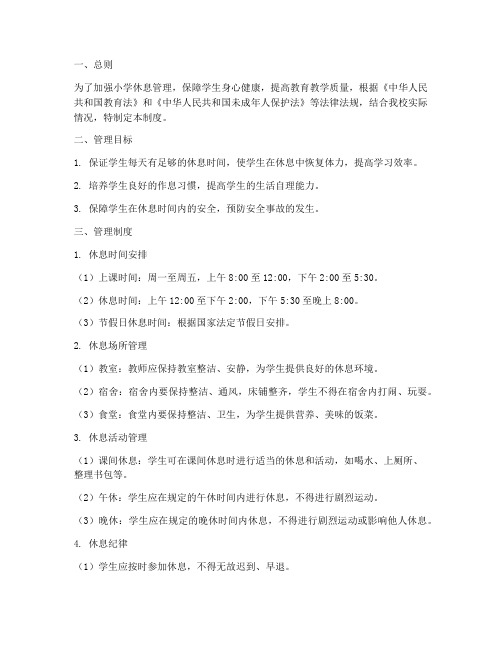
一、总则为了加强小学休息管理,保障学生身心健康,提高教育教学质量,根据《中华人民共和国教育法》和《中华人民共和国未成年人保护法》等法律法规,结合我校实际情况,特制定本制度。
二、管理目标1. 保证学生每天有足够的休息时间,使学生在休息中恢复体力,提高学习效率。
2. 培养学生良好的作息习惯,提高学生的生活自理能力。
3. 保障学生在休息时间内的安全,预防安全事故的发生。
三、管理制度1. 休息时间安排(1)上课时间:周一至周五,上午8:00至12:00,下午2:00至5:30。
(2)休息时间:上午12:00至下午2:00,下午5:30至晚上8:00。
(3)节假日休息时间:根据国家法定节假日安排。
2. 休息场所管理(1)教室:教师应保持教室整洁、安静,为学生提供良好的休息环境。
(2)宿舍:宿舍内要保持整洁、通风,床铺整齐,学生不得在宿舍内打闹、玩耍。
(3)食堂:食堂内要保持整洁、卫生,为学生提供营养、美味的饭菜。
3. 休息活动管理(1)课间休息:学生可在课间休息时进行适当的休息和活动,如喝水、上厕所、整理书包等。
(2)午休:学生应在规定的午休时间内进行休息,不得进行剧烈运动。
(3)晚休:学生应在规定的晚休时间内休息,不得进行剧烈运动或影响他人休息。
4. 休息纪律(1)学生应按时参加休息,不得无故迟到、早退。
(2)学生在休息时间内不得喧哗、打闹,保持安静。
(3)学生不得在休息时间内使用手机、电脑等电子设备。
(4)学生应爱护公共设施,不得损坏。
四、监督检查1. 学校成立休息管理领导小组,负责全校休息管理工作的监督和检查。
2. 各班主任负责本班休息管理工作的落实,定期向学校报告休息管理工作情况。
3. 学校不定期开展休息管理检查,对违反休息管理制度的行为进行严肃处理。
五、奖惩措施1. 对严格遵守休息管理制度的学生,给予表扬和奖励。
2. 对违反休息管理制度的学生,进行批评教育,情节严重的,给予纪律处分。
3. 对在休息管理工作中表现突出的教师,给予表彰和奖励。
PEP人教版小学英语四年级下册第二单元Unit 2 知识点汇总

PEP 人教版英语四年级下册知识点汇总制作:Double Y·LUNIT.2WORD单词1. breakfast 早餐2. English class 英语课3. lunch 午餐4. music class 音乐课5. PE class 体育课6. dinner 正餐7. get up 起床8. go to school 去上学9. go home 回家10. go to bed 上床睡觉单词解析:1.break 打破;休息 fast 快;禁食break(打破)+fast(禁食)=早餐2.English 英语3.PE 体育(physical education,缩写PE或P.E.)4.dinner (中午或晚上吃的) 正餐5.up 向上; 在上面6.go 去 to 向,朝,往go to 去某地7.go home 回家:中间不能加to11. over 结束12. now 现在;目前13. o'clock ……点钟14. kid 小孩15. thirty 三十16. hurry up 快点17. come on 快;加油18. just a minute 稍等一会儿单词拆解:8. clock 时钟9. three 三 third 第三10. hurry 赶快,匆忙 up 向上11. come 来,到达 on 在……上面12. just 正好,不少于minute 分钟, 一会儿breakfast 早餐lunch 午餐dinner 晚餐单词分类记忆English class 英语课music class 音乐课PE class 体育课get up 起床go home 回家go to school 去上学go to bed 上床睡觉over 结束now 现在;目前o'clock ……点钟hurry up 快点come on 快;加油just a minute 稍等一会儿kid 小孩thirty 三十Double Y·L 制 作Knowledge&Grammar知识点及语法What time is it? = What's the time? 现在几点了?二、同义句1. when = what time 什么时候/时间2. supper = dinner 晚饭一、同义词情况方法示例一般情况+s say-says ; run-runs ; get-gets以s、x、ch、sh和o结尾+es watch-watches ; teach-teaches ; go-goes ; do-does 以辅音字母+y结尾变y为i,+es study-studie ; fly-flies 特殊情况不规则have-has三、动词的第三人称单数四、Let's ... (让)我们(做)……吧如:Let's go ! 让我们走吧!Let's go to the playground . 我们去操场吧。
最新新编春五年级英语下册Unit6Workquietly单元知识梳理人教PEP版
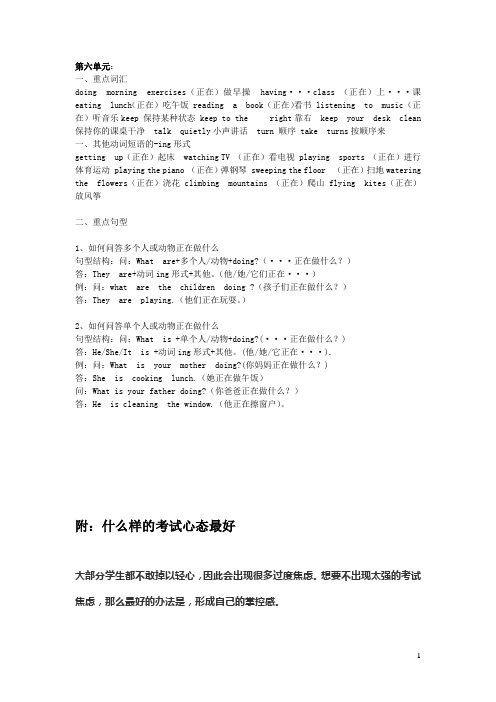
第六单元:一、重点词汇doing morning exercises(正在)做早操having···class (正在)上···课eating lunch(正在)吃午饭 reading a book (正在)看书 listening to music (正在)听音乐keep 保持某种状态 keep to the right靠右 keep your desk clean 保持你的课桌干净 talk quietly小声讲话 turn 顺序 take turns按顺序来一、其他动词短语的-ing形式getting up(正在)起床 watching TV (正在)看电视 playing sports (正在)进行体育运动 playing the piano (正在)弹钢琴 sweeping the floor (正在)扫地watering the flowers(正在)浇花climbing mountains (正在)爬山 flying kites(正在)放风筝二、重点句型1、如何问答多个人或动物正在做什么句型结构:问:What are+多个人/动物+doing?(···正在做什么?)答:They are+动词ing形式+其他。
(他/她/它们正在···)例:问:what are the children doing ?(孩子们正在做什么?)答:They are playing.(他们正在玩耍。
)2、如何问答单个人或动物正在做什么句型结构:问:What is +单个人/动物+doing?(···正在做什么?)答:He/She/It is +动词ing形式+其他。
(他/她/它正在···).例:问:What is your mother doing?(你妈妈正在做什么?)答:She is cooking lunch.(她正在做午饭)问:What is your father doing?(你爸爸正在做什么?)答:He is cleaning the window.(他正在擦窗户)。
作息活动英语单词1到5年级课内课外
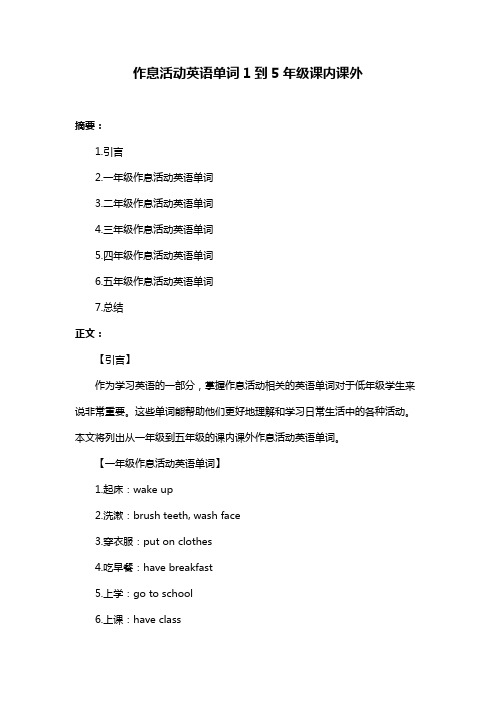
作息活动英语单词1到5年级课内课外摘要:1.引言2.一年级作息活动英语单词3.二年级作息活动英语单词4.三年级作息活动英语单词5.四年级作息活动英语单词6.五年级作息活动英语单词7.总结正文:【引言】作为学习英语的一部分,掌握作息活动相关的英语单词对于低年级学生来说非常重要。
这些单词能帮助他们更好地理解和学习日常生活中的各种活动。
本文将列出从一年级到五年级的课内课外作息活动英语单词。
【一年级作息活动英语单词】1.起床:wake up2.洗漱:brush teeth, wash face3.穿衣服:put on clothes4.吃早餐:have breakfast5.上学:go to school6.上课:have class7.课间休息:have recess8.午餐:have lunch9.午休:have a nap10.下午课程:have afternoon classes11.放学:finish school12.回家:go home13.做作业:do homework14.晚餐:have dinner15.洗澡:take a bath16.睡觉:go to bed【二年级作息活动英语单词】1.早晨:in the morning2.下午:in the afternoon3.晚上:in the evening4.周末:on weekends5.假期:on holidays6.玩耍:play7.画画:draw8.跳舞:dance9.唱歌:sing10.读书:read11.运动:do sports12.学习:study13.朋友:friend14.家庭:family15.老师:teacher16.同学:classmate【三年级作息活动英语单词】1.一周:in a week2.日期:date3.天气:weather4.季节:season5.月份:month6.年度:year7.生日:birthday8.节假日:holiday9.计划:plan10.愿望:wish11.梦想:dream12.目标:goal13.习惯:habit14.爱好:hobby15.性格:personality16.情感:emotion【四年级作息活动英语单词】1.日常活动:daily activities2.周末活动:weekend activities3.学校活动:school activities4.社区活动:community activities5.节日活动:holiday activities6.环保活动:environmental activities7.志愿者活动:volunteer activities8.运动活动:sports activities9.文化活动:cultural activities10.科技活动:tech activities11.艺术活动:art activities12.音乐活动:music activities13.戏剧活动:drama activities14.公益活动:public welfare activities15.郊游活动:outdoor activities16.学习活动:learning activities 【五年级作息活动英语单词】1.早晨:in the morning2.下午:in the afternoon3.晚上:in the evening4.周末:on weekends5.假期:on holidays6.玩耍:play7.画画:draw8.跳舞:dance9.唱歌:sing10.读书:read11.运动:do sports12.学习:study13.朋友:friend14.家庭:family15.老师:teacher16.同学:classmate【总结】通过掌握这些作息活动英语单词,学生可以在日常生活和学习中更好地运用英语。
暑假英语作息时间表

以下是一份暑假英语作息时间表的示例:
早上:
8:00 - 8:30:起床、洗漱
8:30 - 9:00:早餐
9:00 - 10:00:英语听力练习
10:00 - 11:00:阅读英语文章
上午活动:
11:00 - 12:00:英语写作练习
12:00 - 13:00:午餐休息
下午:
13:00 - 14:00:英语词汇学习
14:00 - 15:00:在线英语课程学习
15:00 - 16:00:口语练习
16:00 - 17:00:英语影视欣赏
傍晚:
17:00 - 18:00:户外活动(如跑步、骑自行车等)18:00 - 19:00:晚餐休息
晚上:
19:00 - 20:00:英语语法学习
20:00 - 21:00:英语听力练习
21:00 - 22:00:阅读英语书籍
晚上活动:
22:00 - 22:30:复习一天学习内容
22:30 - 23:00:放松活动(如听音乐、看电视等)
23:00:就寝
请注意,这只是一个示例时间表,你可以根据自己的实际情况和偏好进行调整。
同时,为了避免学习过度疲劳,合理安排休息时间也非常重要。
记得在学习之余留出时间进行休闲活动和社交交流,保持身心健康的平衡发展。
外国小学生作息时间

外国小学生作息时间制定作息时间可以参考别人的,那么你知道外国小学生的作息时间是怎样安排的吗?下面店铺告诉你外国小学生是如何安排作息时间的。
外国小学生作息时间:日本日本的小学生早晨到校时间比国内稍晚,一般都是早上8时30分左右,每天基本都是六节课的安排,下午3时45分左右放学。
除了正式上课之外,一天内还会有很多其他安排,例如打扫卫生、校内午餐、委员会议及参加俱乐部活动等。
家长不需要操心接送目前,在国内几乎每个孩子的上学放学都要由家长负责接送。
日本则完全不同,小学生们上学和放学时一般是与住得较近的同学一起走或由大班的孩子负责带领,家长根本没有专程接送的必要。
在每所小学的校门外的马路上,都会用醒目的颜色画出几十米长的彩色标志,提示过往车辆在此区间内必须耐心等候或慢行,而在孩子们上学放学路途中必经的一些交通要道和人行横道附近往往也有轮流值班的家长维持秩序,保障安全。
此外,在一些繁华的城市街道上,还设置有专门的“通学路段”,在小学生们上学和放学的时间段中进行交通管制。
因此,即使没有专门接送,小学生的安全也不须家长过多操心。
日本的小学分为公立学校和私立学校。
根据日本法律规定,公立学校必须对学生实施免费教育,其中包括了教材费和设施费。
私立学校因为收费高,所占的比重很小。
教育资源分配合理在日本,小学是不分重点与非重点的。
各个学校的设备均按全国统一标准配备,即使是山区学校的设备和东京都内的小学的设备也毫无二致。
日本的小学一般每个年级设有两个班,每班20到30人左右。
每所学校都有一栋教学楼,一个体育馆,一个运动场,一个游泳池。
日本的小学基本都实行“学区入学制”,即我们所说的划片就近入学。
日本政府要求每隔五年对各校的校长和老师进行一次大换班,这样便较好地避免了形成事实上的重点学校,也从客观上减轻了部分家长对学校间差距的担心。
此外,为了保证智力障碍儿童的上学,每所小学一般都设有“向日葵”班,保证他们受教育的权利。
中学时,这些智力障碍的儿童则会被安排进入各个行政区设立的学校进行特殊教育。
米小圈英语作息表
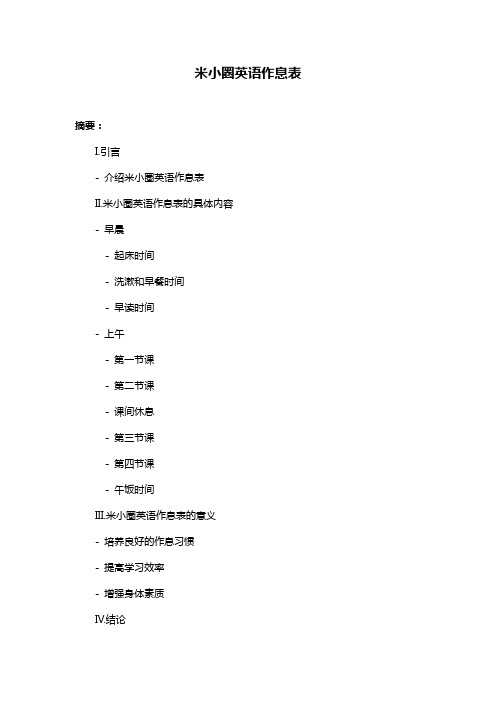
米小圈英语作息表
摘要:
I.引言
- 介绍米小圈英语作息表
II.米小圈英语作息表的具体内容
- 早晨
- 起床时间
- 洗漱和早餐时间
- 早读时间
- 上午
- 第一节课
- 第二节课
- 课间休息
- 第三节课
- 第四节课
- 午饭时间
III.米小圈英语作息表的意义
- 培养良好的作息习惯
- 提高学习效率
- 增强身体素质
IV.结论
- 总结米小圈英语作息表的作用和意义
正文:
米小圈英语作息表是一个为学生制定的英语学习作息计划。
它详细规划了学生一天的学习和生活,旨在帮助学生养成良好的作息习惯,提高学习效率,增强身体素质。
早晨,米小圈英语作息表规定学生需要在早晨六点钟起床,进行洗漱和吃早餐。
之后,学生会有一个小时的早读时间,用于背诵英语单词和句子,为一天的学习打下坚实的基础。
在上午,米小圈英语作息表安排了四节课。
每节课时长为45分钟,课间休息时间为10分钟。
这样的安排可以保证学生有足够的时间进行学习和休息,避免长时间的连续学习导致的疲劳。
此外,每节课都会教授不同的英语知识,如语法、发音等,让学生全面掌握英语知识。
午饭时间过后,学生可以稍作休息,然后继续下午的学习。
下午的学习安排与上午类似,也是四节课和课间休息。
总的来说,米小圈英语作息表是一个科学合理的学习计划,可以帮助学生有效地进行英语学习,提高学习效率。
一年级英语日常生活动作词汇
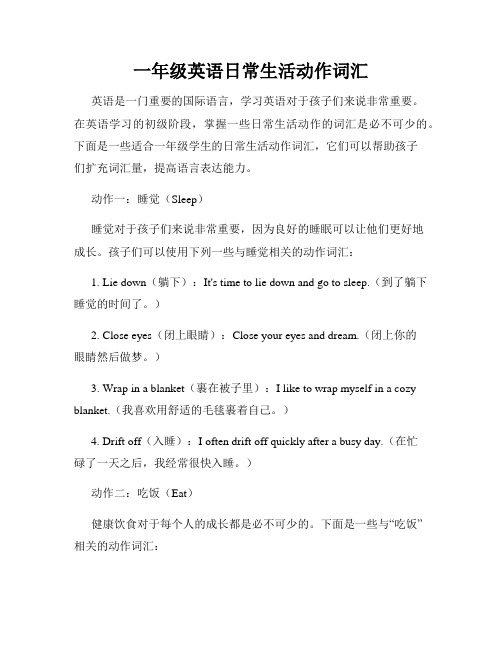
一年级英语日常生活动作词汇英语是一门重要的国际语言,学习英语对于孩子们来说非常重要。
在英语学习的初级阶段,掌握一些日常生活动作的词汇是必不可少的。
下面是一些适合一年级学生的日常生活动作词汇,它们可以帮助孩子们扩充词汇量,提高语言表达能力。
动作一:睡觉(Sleep)睡觉对于孩子们来说非常重要,因为良好的睡眠可以让他们更好地成长。
孩子们可以使用下列一些与睡觉相关的动作词汇:1. Lie down(躺下):It's time to lie down and go to sleep.(到了躺下睡觉的时间了。
)2. Close eyes(闭上眼睛):Close your eyes and dream.(闭上你的眼睛然后做梦。
)3. Wrap in a blanket(裹在被子里):I like to wrap myself in a cozy blanket.(我喜欢用舒适的毛毯裹着自己。
)4. Drift off(入睡):I often drift off quickly after a busy day.(在忙碌了一天之后,我经常很快入睡。
)动作二:吃饭(Eat)健康饮食对于每个人的成长都是必不可少的。
下面是一些与“吃饭”相关的动作词汇:1. Sit down(坐下):Please sit down and have your meal.(请坐下来吃饭。
)2. Use a spoon(使用勺子):Don't forget to use a spoon when you eat soup.(吃汤的时候别忘了用勺子。
)3. Chew(咀嚼):Remember to chew your food properly.(记得把食物咀嚼好。
)4. Swallow(吞咽):Swallow the food and then drink some water.(把食物咽下去之后再喝些水。
)动作三:洗澡(Take a bath)保持良好的卫生习惯对于孩子们的健康至关重要。
中小学生如何休息英语作文
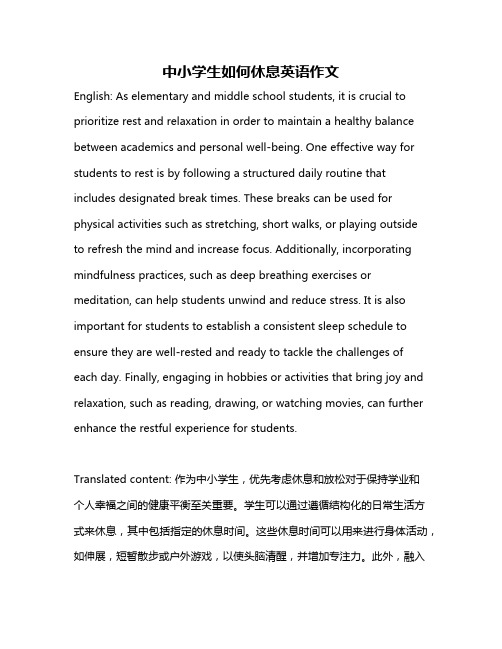
中小学生如何休息英语作文English: As elementary and middle school students, it is crucial to prioritize rest and relaxation in order to maintain a healthy balance between academics and personal well-being. One effective way for students to rest is by following a structured daily routine that includes designated break times. These breaks can be used for physical activities such as stretching, short walks, or playing outsideto refresh the mind and increase focus. Additionally, incorporating mindfulness practices, such as deep breathing exercises or meditation, can help students unwind and reduce stress. It is also important for students to establish a consistent sleep schedule to ensure they are well-rested and ready to tackle the challenges of each day. Finally, engaging in hobbies or activities that bring joy and relaxation, such as reading, drawing, or watching movies, can further enhance the restful experience for students.Translated content: 作为中小学生,优先考虑休息和放松对于保持学业和个人幸福之间的健康平衡至关重要。
如何在学习期问休息
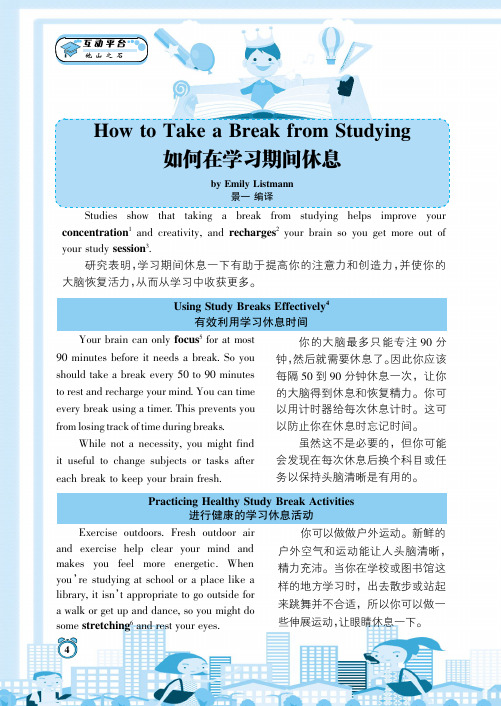
How to Take a Break from Studying如何在学习期间休息by Emily Listmann景一编译他山之石Studies show that taking a break from studying helps improve your concentration 1and creativity,and recharges 2your brain so you get more out of your study session 3.研究表明,学习期间休息一下有助于提高你的注意力和创造力,并使你的大脑恢复活力,从而从学习中收获更多。
你的大脑最多只能专注90分钟,然后就需要休息了。
因此你应该每隔50到90分钟休息一次,让你的大脑得到休息和恢复精力。
你可以用计时器给每次休息计时。
这可以防止你在休息时忘记时间。
虽然这不是必要的,但你可能会发现在每次休息后换个科目或任务以保持头脑清晰是有用的。
你可以做做户外运动。
新鲜的户外空气和运动能让人头脑清晰,精力充沛。
当你在学校或图书馆这样的地方学习时,出去散步或站起来跳舞并不合适,所以你可以做一些伸展运动,让眼睛休息一下。
Using Study Breaks Effectively 4有效利用学习休息时间Your brain can only focus 5for at most 90minutes before it needs a break.So you should take a break every 50to 90minutes to rest and recharge your mind.You can time every break using a timer.This prevents you from losing track of time during breaks.While not a necessity,you might find it useful to change subjects or tasks after each break to keep your brain fresh.Practicing Healthy Study Break Activities进行健康的学习休息活动Exercise outdoors.Fresh outdoor air and exercise help clear your mind and makes you feel more energetic.When you ’re studying at school or a place like a library,it isn ’t appropriate to go outside for a walk or get up and dance,so you might do some stretching 6and rest your eyes.4▌▍▎▏Notes 他山之石短暂的小睡可以帮助你恢复精神,但避免小睡超过20分钟,否则会让你感到更疲劳。
小学1年级学生刷题时的有效休息方法
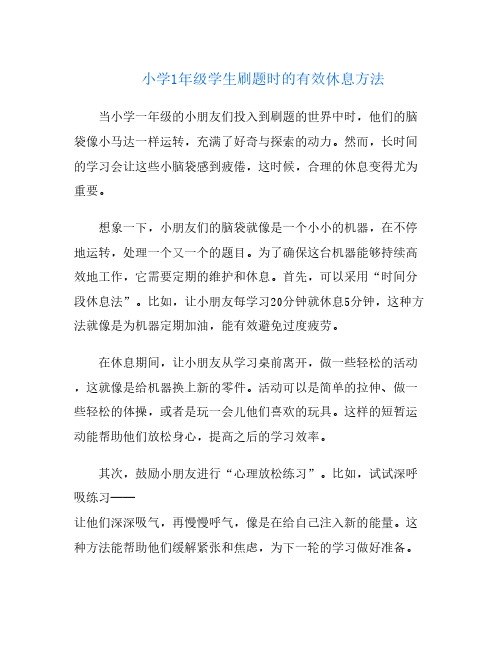
小学1年级学生刷题时的有效休息方法当小学一年级的小朋友们投入到刷题的世界中时,他们的脑袋像小马达一样运转,充满了好奇与探索的动力。
然而,长时间的学习会让这些小脑袋感到疲倦,这时候,合理的休息变得尤为重要。
想象一下,小朋友们的脑袋就像是一个小小的机器,在不停地运转,处理一个又一个的题目。
为了确保这台机器能够持续高效地工作,它需要定期的维护和休息。
首先,可以采用“时间分段休息法”。
比如,让小朋友每学习20分钟就休息5分钟,这种方法就像是为机器定期加油,能有效避免过度疲劳。
在休息期间,让小朋友从学习桌前离开,做一些轻松的活动,这就像是给机器换上新的零件。
活动可以是简单的拉伸、做一些轻松的体操,或者是玩一会儿他们喜欢的玩具。
这样的短暂运动能帮助他们放松身心,提高之后的学习效率。
其次,鼓励小朋友进行“心理放松练习”。
比如,试试深呼吸练习——让他们深深吸气,再慢慢呼气,像是在给自己注入新的能量。
这种方法能帮助他们缓解紧张和焦虑,为下一轮的学习做好准备。
在休息时间,小朋友们也可以进行一些创造性的活动,如画画或听听轻松的音乐。
这样的活动就像是为大脑充电,让他们在享受乐趣的同时,也能重新焕发学习的激情。
这些创意活动有助于释放压力,并激发新的学习动力。
还有一个有效的方法是“定期更换环境”。
让小朋友在学习期间不时地更换学习地点,比如从书桌到地毯上,或者在家里的其他角落学习。
这样可以让他们感受到新鲜感,防止因环境单调而产生的倦怠感。
在休息时间,还可以设置一些“小奖励”来激励小朋友。
比如,每完成一组题目后,可以享受一小块他们喜欢的零食或观看一段喜欢的动画。
这种方法不仅能提高他们的学习积极性,还能使学习变得更加有趣。
通过这些休息方法,小朋友们能够在刷题的过程中保持良好的状态,最终达到最佳的学习效果。
休息不仅仅是为了缓解疲劳,更是为了让他们的脑袋保持清醒,能够更好地迎接下一轮的挑战。
五年级英语冀教版作息,方法(一)
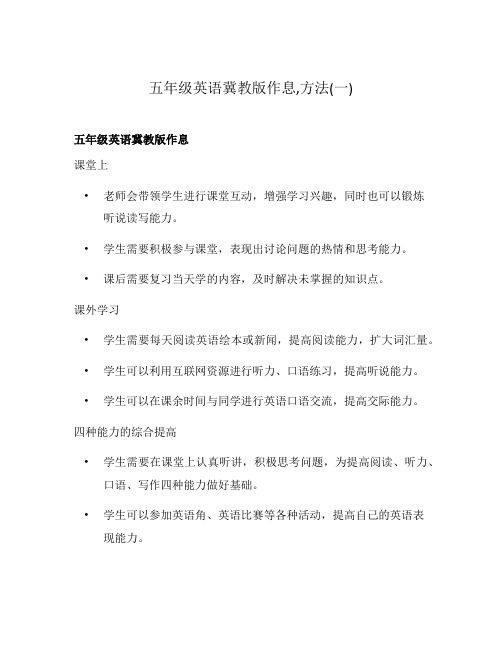
五年级英语冀教版作息,方法(一)五年级英语冀教版作息课堂上•老师会带领学生进行课堂互动,增强学习兴趣,同时也可以锻炼听说读写能力。
•学生需要积极参与课堂,表现出讨论问题的热情和思考能力。
•课后需要复习当天学的内容,及时解决未掌握的知识点。
课外学习•学生需要每天阅读英语绘本或新闻,提高阅读能力,扩大词汇量。
•学生可以利用互联网资源进行听力、口语练习,提高听说能力。
•学生可以在课余时间与同学进行英语口语交流,提高交际能力。
四种能力的综合提高•学生需要在课堂上认真听讲,积极思考问题,为提高阅读、听力、口语、写作四种能力做好基础。
•学生可以参加英语角、英语比赛等各种活动,提高自己的英语表现能力。
•需要在平时生活中,积极扩大自己的英语输入,例如看美剧、听英文歌等,进一步提高英语应用能力。
总结•五年级是学生英语学科中的重要阶段,建议学生在平时的学习中注重四种能力的综合提高,积极参加各种活动,与同伴多交流,不断扩大自己的英语输入,掌握更多的英语知识,为自己的英语学科表现打下坚实的基础。
学习方法•学生需要进行有效的学习方法。
例如,在学习新单词时,可以通过制作单词卡片和自测来加深记忆。
•在学习语法时,可以结合练习来加深理解。
•在写作时,可以利用模板和常用句型来提高写作水平。
课程建议•老师可以结合学生的实际情况进行教学,鼓励学生与老师进行互动,解决困惑,加深理解。
•合理分配课堂时间,将四种能力进行平衡发展,避免重视阅读和试卷分数而忽略听说能力。
•可以适时在课堂上进行游戏、互动等活动,激发学生学习的兴趣和动力,提高学习效果。
家长帮助•家长可以给孩子提供良好的语言环境,例如看外语电影、听英文歌曲、英语绘本等。
•家长可以陪伴孩子一起进行英语学习,鼓励孩子在平时生活中多进行英语交流,为孩子的英语学科表现提供支撑。
结语•学习英语需要长期坚持,建议学生在平时的学习中注重方法的培养、四种能力的整合,并融入到生活中,使英语学习成为一种自然而然的习惯。
五年级任教班休息技术教案
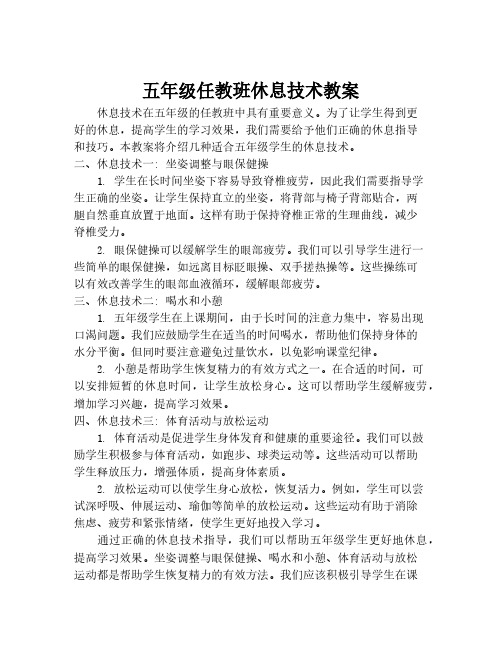
五年级任教班休息技术教案休息技术在五年级的任教班中具有重要意义。
为了让学生得到更好的休息,提高学生的学习效果,我们需要给予他们正确的休息指导和技巧。
本教案将介绍几种适合五年级学生的休息技术。
二、休息技术一: 坐姿调整与眼保健操1. 学生在长时间坐姿下容易导致脊椎疲劳,因此我们需要指导学生正确的坐姿。
让学生保持直立的坐姿,将背部与椅子背部贴合,两腿自然垂直放置于地面。
这样有助于保持脊椎正常的生理曲线,减少脊椎受力。
2. 眼保健操可以缓解学生的眼部疲劳。
我们可以引导学生进行一些简单的眼保健操,如远离目标眨眼操、双手搓热操等。
这些操练可以有效改善学生的眼部血液循环,缓解眼部疲劳。
三、休息技术二: 喝水和小憩1. 五年级学生在上课期间,由于长时间的注意力集中,容易出现口渴问题。
我们应鼓励学生在适当的时间喝水,帮助他们保持身体的水分平衡。
但同时要注意避免过量饮水,以免影响课堂纪律。
2. 小憩是帮助学生恢复精力的有效方式之一。
在合适的时间,可以安排短暂的休息时间,让学生放松身心。
这可以帮助学生缓解疲劳,增加学习兴趣,提高学习效果。
四、休息技术三: 体育活动与放松运动1. 体育活动是促进学生身体发育和健康的重要途径。
我们可以鼓励学生积极参与体育活动,如跑步、球类运动等。
这些活动可以帮助学生释放压力,增强体质,提高身体素质。
2. 放松运动可以使学生身心放松,恢复活力。
例如,学生可以尝试深呼吸、伸展运动、瑜伽等简单的放松运动。
这些运动有助于消除焦虑、疲劳和紧张情绪,使学生更好地投入学习。
通过正确的休息技术指导,我们可以帮助五年级学生更好地休息,提高学习效果。
坐姿调整与眼保健操、喝水和小憩、体育活动与放松运动都是帮助学生恢复精力的有效方法。
我们应该积极引导学生在课间休息时采取适当的休息技巧,使他们在下一节课的学习中更加专心和积极。
中小学生如何休息英语作文
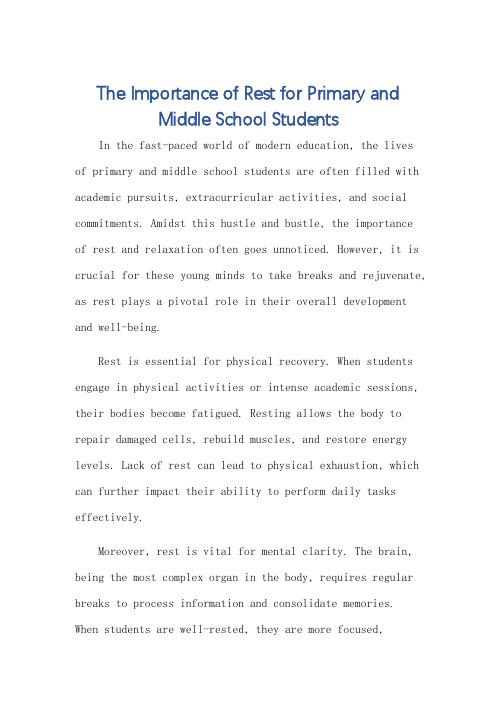
The Importance of Rest for Primary andMiddle School StudentsIn the fast-paced world of modern education, the livesof primary and middle school students are often filled with academic pursuits, extracurricular activities, and social commitments. Amidst this hustle and bustle, the importanceof rest and relaxation often goes unnoticed. However, it is crucial for these young minds to take breaks and rejuvenate, as rest plays a pivotal role in their overall development and well-being.Rest is essential for physical recovery. When students engage in physical activities or intense academic sessions, their bodies become fatigued. Resting allows the body to repair damaged cells, rebuild muscles, and restore energy levels. Lack of rest can lead to physical exhaustion, which can further impact their ability to perform daily tasks effectively.Moreover, rest is vital for mental clarity. The brain, being the most complex organ in the body, requires regular breaks to process information and consolidate memories. When students are well-rested, they are more focused,attentive, and creative. This improved mental clarity leads to better academic performance and enhanced cognitive abilities.Additionally, rest is crucial for emotional stability. The stress and pressure of school life can take a toll on students' emotions. Regular breaks help them regulate their emotions, reducing anxiety and stress levels. A rested mind is more resilient and capable of handling emotional challenges with ease.Moreover, rest is essential for maintaining a healthy lifestyle. When students are well-rested, they are more likely to make healthy choices, such as eating balanced meals, engaging in physical activities, and getting enough sleep. This healthy lifestyle, in turn, contributes totheir overall well-being and academic success.In conclusion, rest is integral to the holistic development of primary and middle school students. It is imperative for schools, teachers, and parents to prioritize rest and relaxation in their educational approach, ensuring that students have ample opportunities to rejuvenate and refresh. By fostering a culture of rest, we can nurturehealthy, happy, and academically successful individuals who are ready to face the challenges of the future.**中小学生休息的重要性**在现代教育这个快节奏的世界里,中小学生的生活往往充满了学术追求、课外活动和社会承诺。
作息活动英语单词1到5年级课内课外
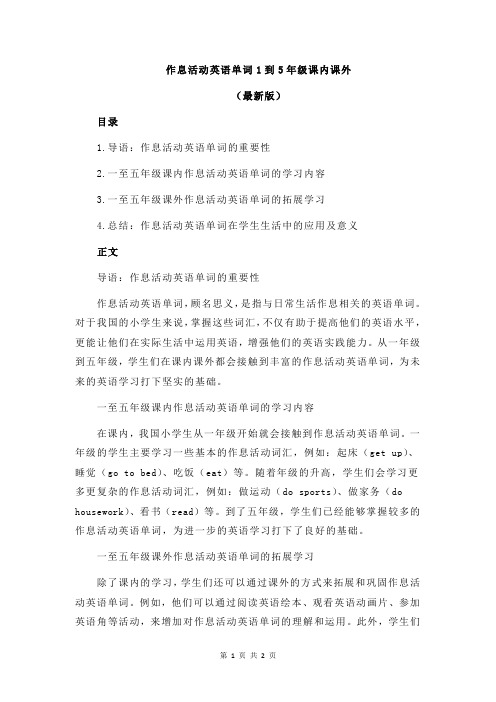
作息活动英语单词1到5年级课内课外(最新版)目录1.导语:作息活动英语单词的重要性2.一至五年级课内作息活动英语单词的学习内容3.一至五年级课外作息活动英语单词的拓展学习4.总结:作息活动英语单词在学生生活中的应用及意义正文导语:作息活动英语单词的重要性作息活动英语单词,顾名思义,是指与日常生活作息相关的英语单词。
对于我国的小学生来说,掌握这些词汇,不仅有助于提高他们的英语水平,更能让他们在实际生活中运用英语,增强他们的英语实践能力。
从一年级到五年级,学生们在课内课外都会接触到丰富的作息活动英语单词,为未来的英语学习打下坚实的基础。
一至五年级课内作息活动英语单词的学习内容在课内,我国小学生从一年级开始就会接触到作息活动英语单词。
一年级的学生主要学习一些基本的作息活动词汇,例如:起床(get up)、睡觉(go to bed)、吃饭(eat)等。
随着年级的升高,学生们会学习更多更复杂的作息活动词汇,例如:做运动(do sports)、做家务(do housework)、看书(read)等。
到了五年级,学生们已经能够掌握较多的作息活动英语单词,为进一步的英语学习打下了良好的基础。
一至五年级课外作息活动英语单词的拓展学习除了课内的学习,学生们还可以通过课外的方式来拓展和巩固作息活动英语单词。
例如,他们可以通过阅读英语绘本、观看英语动画片、参加英语角等活动,来增加对作息活动英语单词的理解和运用。
此外,学生们还可以通过和家长一起制定作息时间表,用英语记录自己的日常作息,以此来提高自己的英语实践能力。
总结:作息活动英语单词在学生生活中的应用及意义作息活动英语单词是我国小学生英语学习中的重要内容,掌握这些词汇,不仅能够提高他们的英语水平,更能让他们在实际生活中运用英语,增强他们的英语实践能力。
英语作业小手杖我的一天作息规律
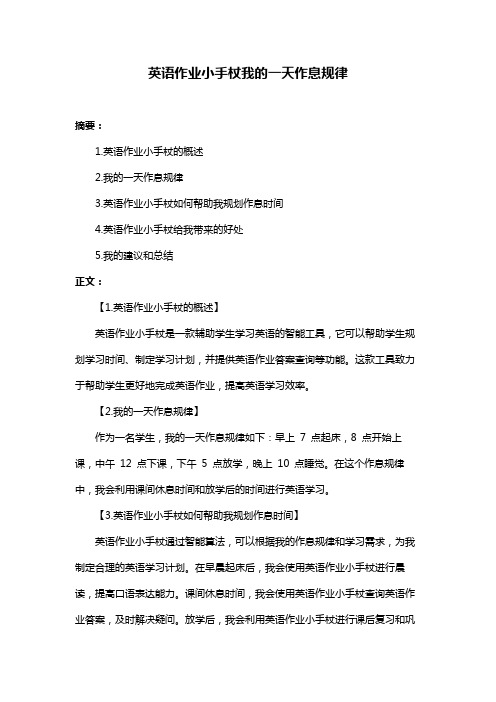
英语作业小手杖我的一天作息规律摘要:1.英语作业小手杖的概述2.我的一天作息规律3.英语作业小手杖如何帮助我规划作息时间4.英语作业小手杖给我带来的好处5.我的建议和总结正文:【1.英语作业小手杖的概述】英语作业小手杖是一款辅助学生学习英语的智能工具,它可以帮助学生规划学习时间、制定学习计划,并提供英语作业答案查询等功能。
这款工具致力于帮助学生更好地完成英语作业,提高英语学习效率。
【2.我的一天作息规律】作为一名学生,我的一天作息规律如下:早上7 点起床,8 点开始上课,中午12 点下课,下午5 点放学,晚上10 点睡觉。
在这个作息规律中,我会利用课间休息时间和放学后的时间进行英语学习。
【3.英语作业小手杖如何帮助我规划作息时间】英语作业小手杖通过智能算法,可以根据我的作息规律和学习需求,为我制定合理的英语学习计划。
在早晨起床后,我会使用英语作业小手杖进行晨读,提高口语表达能力。
课间休息时间,我会使用英语作业小手杖查询英语作业答案,及时解决疑问。
放学后,我会利用英语作业小手杖进行课后复习和巩固。
【4.英语作业小手杖给我带来的好处】英语作业小手杖给我带来的好处有以下几点:1.提高了我的学习效率,让我在有限的时间内学到更多的知识。
2.帮助我养成良好的学习习惯,让我更加自律。
3.提高了我的英语成绩,让我在学习中更有成就感。
【5.我的建议和总结】英语作业小手杖是一款非常实用的学习工具,它对我的英语学习起到了很大的帮助。
在这里,我建议更多的同学可以尝试使用这款工具,提高自己的英语学习能力。
同时,我也认为,学习工具只是辅助手段,关键还是要靠自己的努力。
四年级用英语介绍你上学时的作息安排
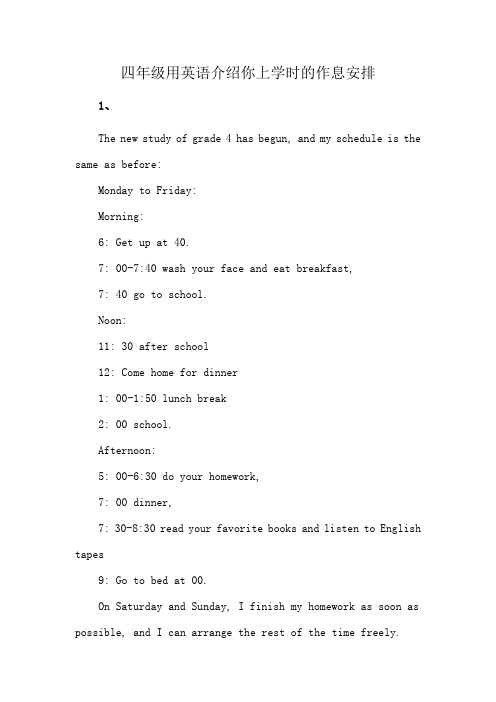
四年级用英语介绍你上学时的作息安排1、The new study of grade 4 has begun, and my schedule is the same as before:Monday to Friday:Morning:6: Get up at 40.7: 00-7:40 wash your face and eat breakfast,7: 40 go to school.Noon:11: 30 after school12: Come home for dinner1: 00-1:50 lunch break2: 00 school.Afternoon:5: 00-6:30 do your homework,7: 00 dinner,7: 30-8:30 read your favorite books and listen to English tapes9: Go to bed at 00.On Saturday and Sunday, I finish my homework as soon as possible, and I can arrange the rest of the time freely.四年级新学习已经开始,我的作息时间一如既往的规律:星期一至星期五:上午:6:40起床。
7:00—7:40洗脸并吃早饭,7:40上学。
中午:11:30放学、12:00到家吃饭、1:00—1:50午休、2:00上学。
下午:5:00—6:30写作业,7:00吃饭,7:30—8:30阅读自己喜欢的书籍和听英语磁带、9:00开始上床睡觉。
星期六和星期天的时间我尽早的先把作业完成,剩下的时间我就可以自由的安排了。
2、The new semester has begun again. I have arranged a new schedule myself:6: Get up and turn on the light as soon as you wake up. Thiswill readjust the body clock and adjust the sleep and wake-up modes. Drink a glass of water. Drinking a glass of water in the morning can supplement the lack of water at night.6: 30-7:10 brush your teeth before breakfast. Brushing your teeth before breakfast can prevent tooth corrosion, because after brushing your teeth, you can apply a protective layer containing fluorine on the outside of your teeth. Or, wait half an hour after breakfast before brushing your teeth.7: 10-7:35 breakfast7: 35-7:40 start school7: 50-11:30 am classroom study11: 30-11:50 lunch.11: 50-12:10 noon homework12: Take a lunch break at 10-12:40. A university study in Athens found that those who took a lunch break of 30 minutes or more every day and at least three times a week had a 37% lower risk of death from heart disease.16: 20-16:40 exercise. According to the biological clock in the body, this time is the best time to exercise, said rivo Nick, a kinematics doctor at Sheffield University.16: 40-19:00.19: 00-19:30 dinner. Eat less dinner. Eating too muchdinner will raise blood sugar, increase the burden on the digestive system and affect sleep. We should eat more vegetables and less food rich in calories and protein for dinner. Eat carefully and slowly.19: 30-20:30 news broadcast. Watch TV. Watching TV at this time to relax will help you sleep, but you should be careful not to lie in bed watching TV, which will affect the quality of sleep.20: 30: take a hot bath. "An appropriate reduction in body temperature is conducive to relaxation and sleep." Professor Jim horn, sleep research center of Lough borough University, said.21:00: go to bed.新学期又开始了,我自己安排了一套全新的作息时间:6:10起床,一醒来,就将灯打开,这样将会重新调整体内的生物钟,调整睡眠和醒来模式。
小学英语课上“休息”方式种种
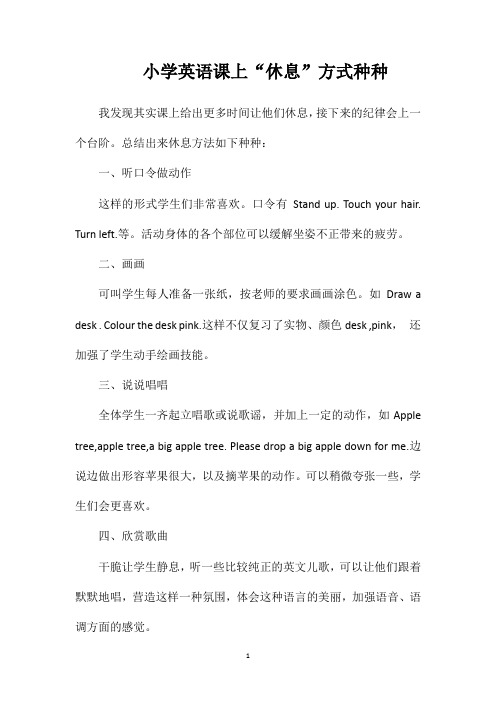
小学英语课上“休息”方式种种我发现其实课上给出更多时间让他们休息,接下来的纪律会上一个台阶。
总结出来休息方法如下种种:
一、听口令做动作
这样的形式学生们非常喜欢。
口令有Stand up. Touch your hair. Turn left.等。
活动身体的各个部位可以缓解坐姿不正带来的疲劳。
二、画画
可叫学生每人准备一张纸,按老师的要求画画涂色。
如Draw a desk . Colour the desk pink.这样不仅复习了实物、颜色desk ,pink,还加强了学生动手绘画技能。
三、说说唱唱
全体学生一齐起立唱歌或说歌谣,并加上一定的动作,如Apple tree,apple tree,a big apple tree. Please drop a big apple down for me.边说边做出形容苹果很大,以及摘苹果的动作。
可以稍微夸张一些,学生们会更喜欢。
四、欣赏歌曲
干脆让学生静息,听一些比较纯正的英文儿歌,可以让他们跟着默默地唱,营造这样一种氛围,体会这种语言的美丽,加强语音、语调方面的感觉。
- 1、下载文档前请自行甄别文档内容的完整性,平台不提供额外的编辑、内容补充、找答案等附加服务。
- 2、"仅部分预览"的文档,不可在线预览部分如存在完整性等问题,可反馈申请退款(可完整预览的文档不适用该条件!)。
- 3、如文档侵犯您的权益,请联系客服反馈,我们会尽快为您处理(人工客服工作时间:9:00-18:30)。
小学英语课上“休息”方式种种
小学英语课是一种活动课,是在一定的情景下完成教学任务的。
小学生年龄小,有意注意时间短。
一节课中往往开头一部分时间坐得端正、听得认真,后面开始操练时就没有节制地“活动”了。
这时候,可以利用小学生个个争强好胜的心理。
“比比哪个小朋友表现最好”。
但这也只能持续一小段时间。
我发现其实课上给出更多时间让他们“休息”,接下来的纪律会上一个台阶。
总结出来“休息”方法如下种种:
一、听口令做动作
这样的形式学生们非常喜欢。
口令有“Stand up. Touch your hair. Turn left.”等。
活动身体的各个部位可以缓解坐姿不正带来的疲劳。
二、画画
可叫学生每人准备一张纸,按老师的要求画画涂色。
如”Draw a desk . Colour the desk pink.”这样不仅复习了实物、颜色“desk ,pink”,还加强了学生动手绘画技能。
三、说说唱唱
全体学生一齐起立唱歌或说歌谣,并加上一定的动作,如“Apple tree,apple tree,a big apple tree. Please drop a big apple down for me.”边说边做出形容苹果很大,以及摘苹果的动作。
可以稍微夸张一些,学生们会更喜欢。
四、欣赏歌曲
干脆让学生静息,听一些比较纯正的英文儿歌,可以让他们跟着默默地唱,营造这样一种氛围,体会这种语言的美丽,加强语音、语调方面的感觉。
